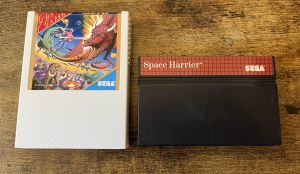Master System:Region Information
Japanese/Korean
Both the Sega Mark III and Japanese Master System use the same 44-pin cartridges as their predecessor, the SG-1000. These cartridges are taller, narrower and thicker than the 50-pin cartridges used in the West and so are not compatible on a hardware level. While there are adapters which allow for Western cartridges to be played on Japanese consoles, commercially available adapters for the opposite do not currently exist. Korean Master System consoles such as those sold by Samsung also use the same 44-pin cartridges as Japanese consoles. SG-1000 games are also backwards compatible on Japanese and Korean hardware.
Japanese games were packaged in small cardboard boxes that were only slightly larger than the game card/cartridge itself, with a few games (i.e. Phantasy Star, Haja no Fuuin/Miracle Warriors) receiving special packaging.
Western
When the Mark III was brought over to North America as the Sega Master System in 1986, Sega used this opportunity to revise the system's cartridge slot and added several additional signals. This also necessitated a new form factor for cartridge games, similar in size to Famicom and Sega Genesis/Mega Drive cartridges and using 50 pins. This design was also used for the SMS in all PAL regions and in Brazil.
With some exceptions, NTSC, PAL and Brazilian SMS games can be played without issues across consoles, as the SMS BIOS does not make a distinction between these regions. Many SMS games that also saw a release in Japan and North America were not optimized for 50 Hz and so will run slower on PAL consoles. The opposite is also true for some PAL releases (i.e. Power Strike II and RoboCop vs. The Terminator), as they were programmed for 50 Hz and will run faster than intended on an NTSC console. Some PAL games also exhibit varying degrees of graphical glitching when played on NTSC consoles due to these games being strictly programmed for 50 Hz, and a handful will not work at all (Codemasters games, Back to the Future III, California Games II, etc).
The SMS BIOS does however check for a header file within the game code; if this header is not present, the system will not boot to the game. Because of this, some Japanese games and all SG-1000 games are not compatible on Western consoles, even if one constructs a cartridge adapter for playing Japanese or Korean cartridges. The BIOS issue also affects Sega Card/My Card games. This can be bypassed by performing a BIOS mod or building a cartridge adapter which contains a small boot ROM containing the header file. Flash carts such as the Master Everdrive are not affected by this issue.
For most Western markets, Sega packaged games in sturdy plastic clamshell cases as opposed to the thin cardboard boxes used in Japan. Early Brazilian releases were packaged in flimsy cardboard boxes but Tec Toy later switched to the plastic clamshells.
